Protecting Dobbs Ferry Homes from Flood Damage
7/11/2022 (Permalink)
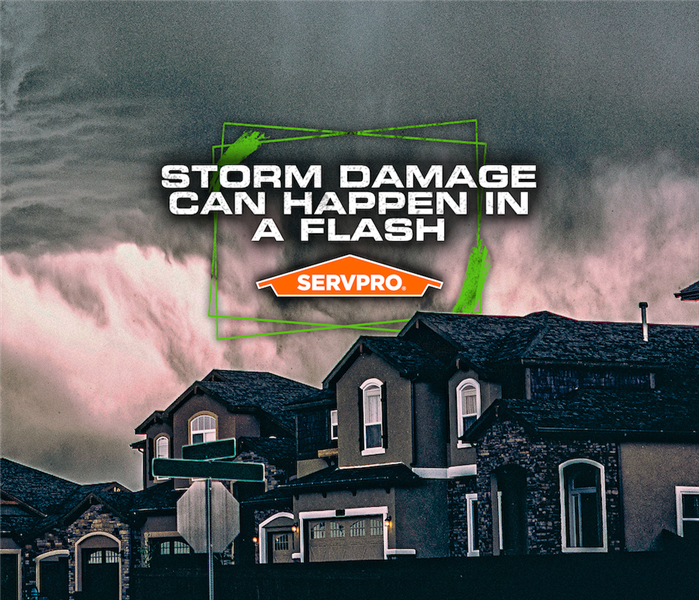 Storm damage restoration for Dobbs Ferry homes need the help of SERVPRO. We are ready at a moment's notice.
Storm damage restoration for Dobbs Ferry homes need the help of SERVPRO. We are ready at a moment's notice.
SERVPRO Water Restoration Technicians Are Available
Violent storms are usually noticed ahead of time. Weather warnings on local radio, television, and websites can help homeowners prepare for an incoming natural disaster and secure their safety. However, it is much harder to protect your home from potential flooding and wind damage which are common in adverse weather conditions.
One method of preparing for flood damage to your Dobbs Ferry home is to ensure that your insurance is up-to-date and covers natural disasters. Another is finding a reliable restoration service with experience in emergency mitigation and natural disasters. SERVPRO has extensive experience helping local homeowners recover from the damaging effects of storms on personal property. We operate twenty-four hours a day so that you can arrange an emergency callout. Our technicians are trained to identify potential losses from natural events and reduce them by performing countersteps and procedures. We can help with:
- Ceiling leaks from storms
- Flood damage
- Water Removal
High winds can damage roofing materials and open entranceways for rainwaters to enter the property. One emergency mitigation procedure we perform is covering these entranceways with thick tarpaulin sheeting. Using a staple gun, we can affix sheeting as a temporary barrier to reduce potential water issues. If windows or doors are damaged during a storm, our team can board up these areas using sturdy plywood boards drilled into place. Boarding the property like this can protect interior rooms from wind or rain. It can also deter unlawful entry into the property. Properties that become flooded often have mains power shut off to prevent electrical malfunctions. Our team can bring in portable generators for power and mobile lighting equipment to allow work to continue even when mains power is shut off.
- Wearing correct personal protective equipment (PPE) such as thick gloves, steel cap boots, face protection, and eyewear is essential in flooded properties.
- Water brought into the property from outdoors is frequently contaminated and should be avoided.
- Slip and trip hazards and faulty electrical equipment can threaten your safety in a flood situation.
Contact SERVPRO of Tarrytown / Elmsford for emergency assistance for flood damage at (914) 358-9000.
Repairing Flood Damage for Tarrytown Properties
7/11/2022 (Permalink)
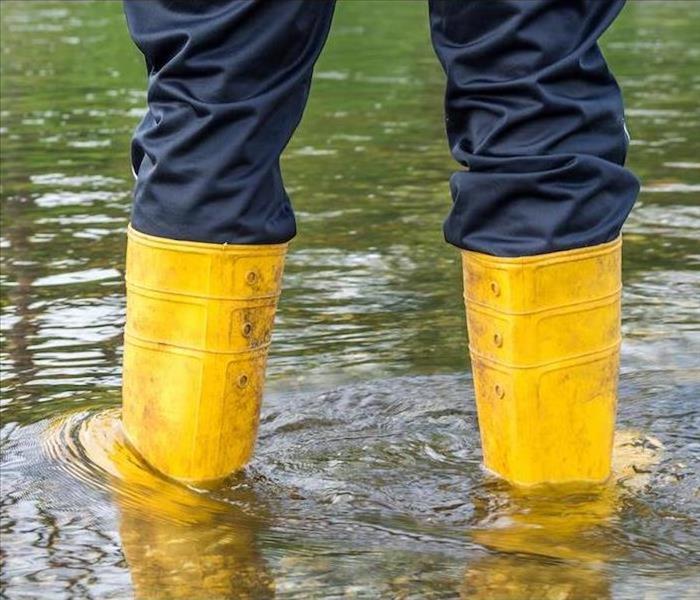 Tarrytown homes in need of flood damage restoration services should call SERVPRO. Our team has the equipment and experience for every phase of help.
Tarrytown homes in need of flood damage restoration services should call SERVPRO. Our team has the equipment and experience for every phase of help.
SERVPRO Flood Damage Services Help Local Residents
Natural disasters can cause damage to your home. A violent storm produces strong winds, heavy rainfall, and, in some cases, flooding in the local area. Sometimes these conditions reach your property, causing harm. SERVPRO is a licensed restoration service to help return your home to its preloss state.
Tackling flood damage in Tarrytown requires organization, equipment, and training. A systematic approach can help ensure that your home suffers as little damage as possible. We do recommend that you contact a professional restoration service the moment your safety is secured. Our technicians are adept at emergency mitigation services designed to minimize losses to your belongings and the structure of your home. Examples of emergency mitigation include pumping and water extraction equipment, which rapidly reduce standing water levels and help prepare the site for fast-drying. By removing water quickly, our technicians reduce the likelihood of:
- Flood Damage
- Water Degradation
- Structural Damage from Storms
Emergency mitigation procedures form a basis for restoration. Once the property is in a safe state, our technicians can begin to reverse damages by performing deep cleaning, deodorizing, and repairs to structures or belongings. Floodwaters that enter a property are considered biohazardous. This categorization is due to debris, pathogens, and dirt in floodwaters. When dealing with biohazardous waste, following strict guidelines when performing restoration is essential to ensure that your property returns to a sanitary state. Contamination in water infects anything it comes into contact with, including gypsum board, flooring, textiles, and fixtures. If materials are dense, finished, or otherwise non-porous, there may be an opportunity to perform deep cleaning and disinfection to remove contaminants. Porous materials must be disposed of after coming into contact with floodwater.
- Solid woods used in the framing of your home, floorboards, and furniture may be repairable, providing technicians are brought in quickly to mitigate damages.
- Materials such as plaster and stud walls are usually cut away a few inches above the point of contact with floodwaters and replaced with new, matching materials.
- Ceilings, subfloors, and other cavities in the home often have to be thoroughly dried using applied structural drying equipment.
Floods can be unexpected and traumatic. Contact SERVPRO of Tarrytown / Elmsford for flood damage assistance at (914) 358-9000.
Hardwood Floors in a Dobbs Ferry Home Suffer due to Flood Damage
5/26/2022 (Permalink)
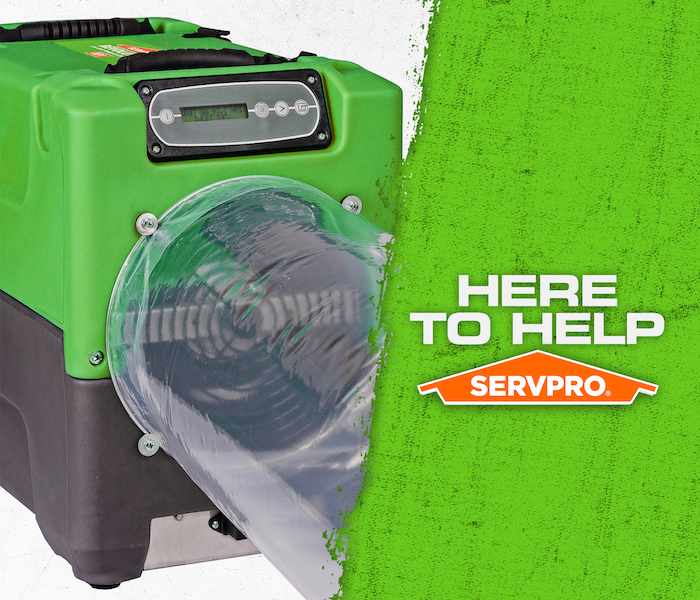 SERVPRO flood damage restoration technicians use the latest technology and equipment for every disaster.
SERVPRO flood damage restoration technicians use the latest technology and equipment for every disaster.
Call SERVPRO for Help with Water Damage Restoration in Dobbs Ferry
The hardwood floors of your Dobbs Ferry home most likely add timeless character to your home, and when floodwater damages them, the outlook may seem grim. As you evaluate your situation, you probably worry about the cost and the quality of the repairs. Most importantly, you need to know whether the water and debris that made its way into your home have damaged the floors forever or if they can be salvaged.
To assess flood damage in Dobbs Ferry, call SERVPRO and let us use our specialized equipment and establish a plan for restoring your home. We pride ourselves on being quick to react so your home doesn’t suffer from standing water longer than necessary. Mold growth is typical after a water event, and your home’s structure can also suffer from prolonged water exposure. As far as hardwood floors are concerned, three common issues occur whenever the floors absorb excess moisture:
- Buckling, which happens when wood planks separate from the subfloor
- Cupping, observed by a downward curvature of the floor
- Crowning, which presents an upward rise of the wood planks
As the homeowner, your instinct may move you to find the most powerful dehumidifier possible to restore natural humidity levels and allow the hardwood floor to settle back into its original shape. Although removing excess humidity is critical to the water restoration process, it has to be done methodically by constantly observing changes to the flooring and adjusting your efforts. Even your subfloor runs the risk of mold growth if it’s not treated correctly. Thankfully, SERVPRO has the knowledge and experience to help you. When restoration is not possible, we can also handle the removal and disposal of the flooring materials.
SERVPRO of Tarrytown/Elmsford is ready to help in the toughest situations. Call us at (914) 358-9000 and invite our team of experts to leave your home “Like it never even happened.”
Water Damage to Tarrytown Homes Caused by Storms is Unpredictable
5/15/2022 (Permalink)
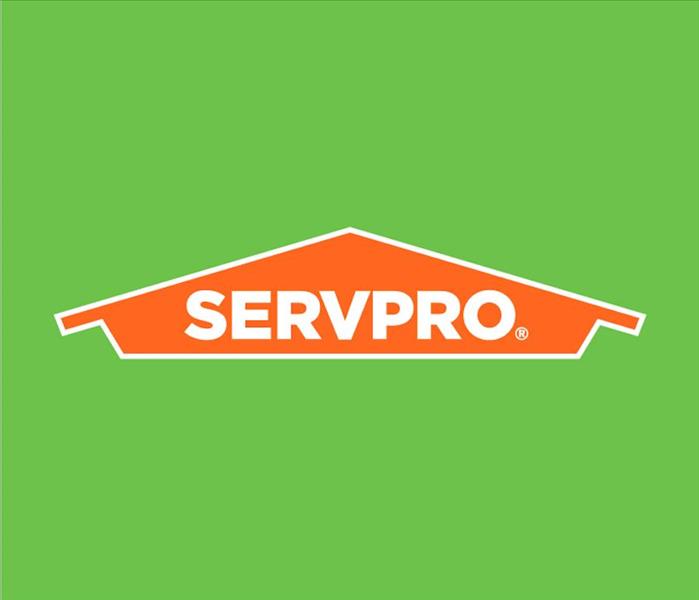 Storm and flood damage restoration services for your home is a job for SERVPRO. We have the equipment and experience needed.
Storm and flood damage restoration services for your home is a job for SERVPRO. We have the equipment and experience needed.
Prepare for the Unexpected by Including a Water Restoration Company in your Tarrytown Home’s Safety Plan
Prevention is important in almost everything we do in life. It is critical for your health, but it is also crucial to protect your home. A winter storm in Tarrytown can cause as much damage as a torrential summer downpour, so thinking ahead of what to do if water damage puts you in a good position to act quickly when disaster strikes. Identifying who can provide the latest in water extraction and removal is the first step in being ready.
Property owners in Tarrytown know that storm damage remediation is a job for SERVPRO and its team of experts. The impact of floodwater in your home can be devastating if water extraction and drying happen beyond the 48 hours after the incident. Storms, in particular, bring with them contaminants and debris that require careful attention. Our highly skilled staff is ready around the clock to assist you in assessing how widespread the water damage is and begin the restoration process without delay. Most importantly, we inspect the whole property, even those areas seemingly unaffected by the storm.
As you watch our SERVPRO certified crew, you may notice that we concentrate on three main goals when we enter your home-
Water extraction- using pumps and state-of-the-art extractors, we remove standing water from each room. Advanced monitoring tools help us detect hidden deposits, and we take care of those.
Disinfection- we apply anti-microbial solutions to prevent mold growth and disinfect surfaces. Our equipment aims to penetrate every surface in the home, including furniture, fixtures, and structural elements.
When relevant, our staff takes care of drywall replacement and other repairs. All our actions are carefully documented for record-keeping purposes and for support in the insurance claim process as needed.
At SERVPRO of Tarrytown/Elmsford, we work with you from the minute you call us at (914) 358-9000. With our assistance, your home will feel and look “Like it never even happened.”
Storms in Tarrytown Can Lead to Extensive Flood Damage
4/28/2022 (Permalink)
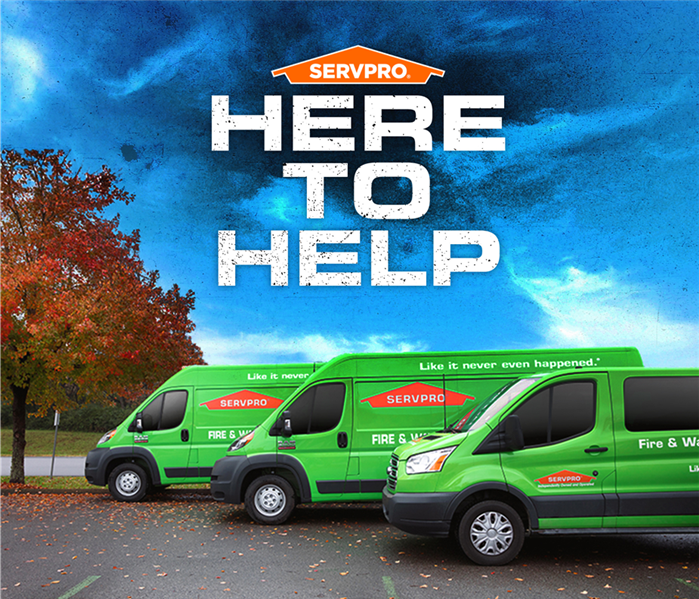 SERVPRO is Here To Help when storm damage cleanup is required in Tarrytown
SERVPRO is Here To Help when storm damage cleanup is required in Tarrytown
SERVPRO Is a Licenced Flood Damage Restoration Service in Tarrytown
Violent storms and gale-force winds can quickly become natural disasters by causing widespread flooding. These elemental disasters can cause water damage and structural damage to your home. Once you have secured your safety, you must contact a licensed restoration service to help repair the damages and mitigate losses.
When flood damage strikes your Tarrytown home, it is vital to act quickly. The first few days of a restoration project are often the most valuable in terms of saving belongings and reducing pressure on the structure of your home. The sheer weight of standing water can exert enormous pressure onto the walls, jointing, floors, and property foundations. Equally, any structural insecurities could expose the property to rainfall, theft, and unlawful entry. In severe storms, electrical faults can occur across neighborhoods resulting in a widespread power outage. SERVPRO is a recognized storm restoration provider. We act fast in an emergency to mitigate many of the losses that are common in natural disasters, including:
Our equipment includes portable generators and full-scale lighting to allow technicians to work in a flooded building efficiently. These portable generators can power pumping and extraction equipment for up to twelve hours which allows our technicians to extract liquid quickly. By alleviating water weight and its pressure on floors, walls, and ceilings, we can significantly reduce the risk of structural collapse. Our technicians can safely secure the property by boarding up potential entranceways with sturdy plywood boards bolted into place to discourage potential theft and trespass. We can also waterproof the property by fitting tarpaulin over any gaps in the roof or windows where rainwater could potentially enter.
Contamination in floodwaters
- Contamination is measured in three distinct classes: clean, grey, and black. Blackwater contamination presents the most risk and causes the most damage.
- Most floods are categorized as blackwater damages since they can bring human pathogens, herbicides, animal carcasses, and debris into the home environment.
- Porous materials that show exposure to class three contamination (black) must be destroyed and replaced to return the property to a safe state.
Act quickly to reduce storm damage in your home. Contact SERVPRO of Tarrytown / Elmsford for flood damage assistance at (914) 358-9000.
When Winter Weather Strikes
12/13/2021 (Permalink)
 Ask your local SERVPRO Franchise Professional about starting a Disaster Recovery Plan for your business.
Ask your local SERVPRO Franchise Professional about starting a Disaster Recovery Plan for your business.
When Winter Weather Strikes...SERVPRO Strikes back! Here are some tips for your home when the winter storm comes in.
Tips for Preparing your Home for Winter Weather
- Keep cabinet doors open during cold spells. This allows warm air to circulate around the pipe.
- Keep a slow trickle of water flowing through faucets, especially if the pipes for faucets run through unheated or uninsulated areas of your home.
- Consider shutting off outdoor faucets. Find the shut-off valve in the basement or crawl space and turn it to "off.
- If you follow the previous step, then open the outdoor faucet to help ensure it drains completely and the inner valve is shut off.
- Ensure gutters are clean and secure. Leaves and debris accumulate, causing a damming effect on gutters, which could lead to roof problems and water damage.
- Proper maintenance of your furnace can help reduce the risk of puff backs.
Frozen Pipes
A Frozen pipe can burst at the point where the ice blockage inside the pipe is located, but typically the rupture is caused by the backflow pressure between the water source and the blockage. A burst pipe can cause considerable damage to your property if not addressed quickly. Your SERVPRO Franchise Professional is faster to any size disaster, bringing the latest equipment and training to help make your water damage "Like it never even happened."
Ice Dams
Ice dams can be a major problem during the winter season. They form when heated air melts roof snow downward into water dammed behind still-frozen ice. When the trapped water cannot safely flow or run into the gutter system, it can backflow under the roof's shingles and into the structure's interior areas. Your local SERVPRO Franchise Professional can help mitigate water damage caused by ice dams and help you get your structure back to preloss condition.
Puff Backs
A puff back is a messy furnace malfunction that occurs when an oil burner backfires, sending soot throughout your home or business. It can happen all at once, covering an interior in grimy soot, or a puff back can leak soot particles more gradually. Equipped with the training, tools, and experience to quickly and efficiently clean and restore your home or business, your SERVPRO Franchise Professional will help make your puff back "Like it never even happened."
Flu Season
Help prevent the spread of flu germs. Homes and businesses can depend on their local SERVPRO Franchise Professional to clean and sanitize building materials, surfaces, and contents following restoration industry standards, using professional cleaning products and EPA-registered cleaners and disinfectants. SERVPRO Franchise Professionals are also trained and equipped to clean your HVAC and duct systems to help provide better air quality and help reduce the risk of circulating harmful contaminants.
Prepare Your Business for Winter Weather
- Check your business property for downed tree limbs and branches. Weather, such as wind, heavy rain, ice, and snow, can cause branches to fall, which could cause damage to the property and potentially cause personal injuries.
- Inspect property, especially walkways and parking lots, for proper drainage to alleviate flood hazard potential.
- Inspect all handrails, stairwells, and entryways to address and correct potential slippery or hazardous areas. Install mats or non-slip surfaces and post caution signs where water could be present.
- Ask your local SERVPRO Franchise Professional about starting a Disaster Recovery Plan for your business.
Build a kit with everyone in Mind!
9/23/2021 (Permalink)
Build A Kit
After an emergency, you may need to survive on your own for several days. Being prepared means having your own food, water and other supplies to last for several days. A disaster supplies kit is a collection of basic items your household may need in the event of an emergency.
Basic Disaster Supplies Kit
To assemble your kit store items in airtight plastic bags and put your entire disaster supplies kit in one or two easy-to-carry containers such as plastic bins or a duffel bag.
A basic emergency supply kit could include the following recommended items:
- Water (one gallon per person per day for several days, for drinking and sanitation)
- Food (at least a three-day supply of non-perishable food)
- Battery-powered or hand crank radio and a NOAA Weather Radio with tone alert
- Flashlight
- First aid kit
- Extra batteries
- Whistle (to signal for help)
- Dust mask (to help filter contaminated air)
- Plastic sheeting and duct tape (to shelter in place)
- Moist towelettes, garbage bags and plastic ties (for personal sanitation)
- Wrench or pliers (to turn off utilities)
- Manual can opener (for food)
- Local maps
- Cell phone with chargers and a backup battery
How to Clean Your Gutters
9/1/2021 (Permalink)
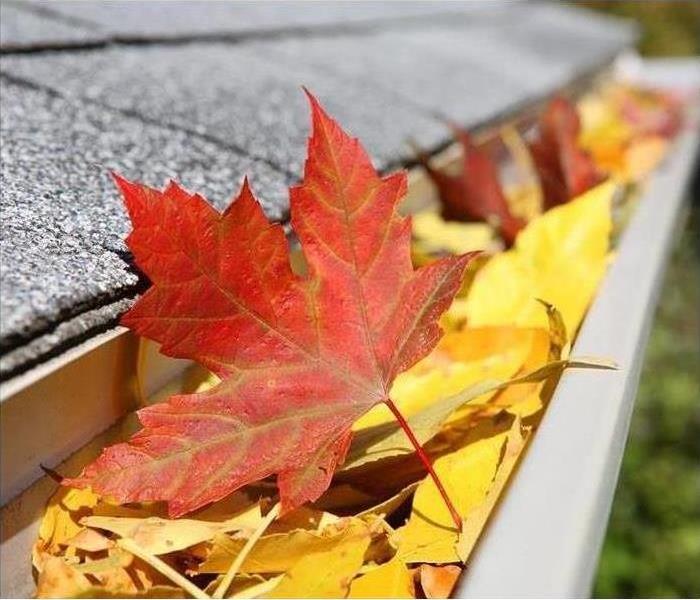 Fall is the perfect time to check your gutters!
Fall is the perfect time to check your gutters!
"Preparing to Work on Your Gutters
Thoroughly cleaning your home’s gutters every spring and fall will keep them working like they should. Leaves can build up and clog the downspouts, which can cause water damage to your roof and fascia (the board behind the gutter). Water pouring over the gutters or from leaks can end up next to your home’s foundation, in the basement or crawlspace.
Cleaning the Gutters
A hose-end attachment specially designed for gutters may make this project a lot easier. If you need to clean from a ladder, follow these steps.
Step 1
Begin cleaning the gutter near a downspout.
Step 2
Remove the large debris (leaves, twigs, etc.) with a trowel and dump it in a bucket.
Step 3
To clean out finer materials, flush the gutter lengths with a hose starting at the end opposite the downspout. Alternatively, you can use a gutter-cleaning attachment on a hose. If the water doesn’t drain, recheck the downspout strainer and clean as necessary.
If gutter water still doesn’t drain, the downspout may be clogged.
- Check the drain end. If the downspout runs underground, remove it from the pipe as needed.
- Install a small nozzle on the hose, and lock it at full pressure. Turn on the water and feed the hose up from the bottom of the spout. If this doesn’t clear the downspout or the nozzle is too big, use a plumber’s snake tool to clear the blockage.
- Reattach the downspout.
- Flush the entire gutter again.
- Be sure to clean the downspout strainers.
Gutter Maintenance and Repair
Step 1
If there's still standing water after the gutter has been flushed, the gutter may not be sloped correctly and will require adjustment. The length of the system should decline at least ¼ inch every 10 feet toward the downspout.
If the gutter doesn’t slope enough, detach the hangers and adjust the gutter enough to drain properly, then reattach. It may be easier to work on small sections at a time to prevent the entire gutter system from falling.
Step 2
Inspect the gutter sections and downspouts for obvious damage and missing parts. Support hangers should be spaced every 2 feet along the gutter.
To replace or add hangers:
- Install screw and ferrule hangers by marking their position on the gutter, drilling the holes in the gutter lip and fascia, then driving the screw with a drill through the ferrule.
- Install screw-in or hidden hangers following the manufacturer’s directions. Most are attached through the rear of the gutter and into the fascia board, then clipped to the inside-front of the gutter.
- If no fascia board exists, use roof hangers with straps, following the package instructions. Typical installation involves attaching a hanger across the gutter channel, clipping a strap to the hanger, then attaching the hanger under the shingles.
Step 3
Repair any leaks in the gutter.
- To repair leaks at the seams, make sure the gutter lengths are tight against each other, and run a bead of gutter sealant on both sides of all joints.
- To repair leaks at the end caps, add sealant along the inside of the joint.
- To repair holes in the gutter material, ask a Lowe’s associate for products designed to repair aluminum or fiberglass gutters.
Step 4
Apply gutter touch-up paint to cover any blemishes as desired. If necessary, repaint some or all of the gutters."
Hurricane Preparedness Week 2021
5/11/2021 (Permalink)
 Hurricane Preparedness Week
Hurricane Preparedness Week
Hurricane Preparedness Week starts today and we are sharing tips to help you create a plan. Here are some things you can do this week to prepare:
Day 1: Create an Emergency Plan
Start by creating an emergency plan for your family that includes emergency meeting places in your home, neighborhood, and outside your neighborhood. Create a plan here.
Day 2: Build an Emergency Kit
Build an emergency kit to have at work, in your car, and at home. This could include a backpack, water, nonperishable food, a blanket, etc. See the full list here.
Day 3: Review and Gather Documents
Look at your policies ahead of time to see what's covered and if flood insurance is available to you since it's the leading cause of damage from tropical systems. For more insurance tips visit https://bit.ly/2PupnxJ.
Day 4: Be Informed
Plan your route and have an alternate. Remember, you may not have to drive hundreds of miles to evacuate, only far enough away from the evacuation area.
Day 5: Strengthen Your Home
Trim your trees to prevent damage from snapped branches and board up your windows to protect them from flying debris. For more ways to strengthen your home click here.
Tornadoes!
5/5/2021 (Permalink)
 Tornado
Tornado
Tornadoes are arguably nature's most violent storms. Generated from powerful thunderstorms, tornadoes generally appear as rotation, funnel-shaped clouds extending form the cloud base to the ground. With winds that can reach up to 300 miles per hour, tornadoes can cause massive destruction within seconds. Damage paths can be in excess of one mile wide and fifty miles long.
The average tornado moves southwest to northeast, but tornadoes have been known to move in any direction.
The average forward speed of a tornado is 30 miles per hour, but may vary from stationary to 70 miles per hour.
Tornadoes can accompany tropical storms and hurricanes as they move onto land.
Tornadoes are most frequently reported east of the Rocky Mountains during spring and summer months.
Tornadoes are most likely to occur between 3 p.m. and 9 p.m.
For more information, email our office at SERVPRO9937@jdcrestoration.com or give us a call at (914) 358-9000.
Flash Flooding
5/4/2021 (Permalink)
 Heavy rainfall
Heavy rainfall
Flash Flooding
Floods are among the most frequent and costly natural disasters in terms of human hardship and economic loss. As much as 90 percent of the damage related to all natural disasters (excluding droughts) is caused by floods and associated debris flows. Most communities in the United States can experience some kind of flooding. Over the 10-year period from 1988 to 1997, floods cost the Nation, on average, $3.7 billion annually. Flash floods occur within six hours of a rain event, or after a dam or levee failure, or following a sudden release of water held by an ice or debris jam, and flash floods can catch people unprepared. You will not always have a warning that these deadly, sudden floods are coming. So if you live in areas prone to flash floods, plan now to protect your family and property.
Know the Difference Between Watches and Warning
A National Weather Service (NWS) WATCH is a message indicating that conditions favor the occurrence of a certain type of hazardous weather. The NWS Storm Prediction Center issues such watches. Local NWS forecast offices issue other watches (flash flood, winter weather, etc.) 12 to 36 hours in advance of a possible hazardous-weather or flooding event. Each local forecast office usually covers a state or a portion of a state.
An NWS WARNING indicates that a hazardous event is occurring or is imminent in about 30 minutes to an hour. Local NWS forecast offices issue warnings on a county-by-county basis.
Plan for a Flood
- Develop a Family Disaster Plan. Please see the "Family Disaster Plan" section for general family planning information. Develop flood- specific planning.
- Contact your local Red Cross chapter, emergency management office, local National Weather Service office, or planning and zoning department about your area's flood risk.
- Knowing the elevation of your property in relation to nearby streams and dams will let you know if forecasted flood levels will affect your home.
SERVPRO of Tarrytown/Elmsford's trained technicians are available 24/7 to assist with your cleanup and restoration needs, call (914)358-9000
What should I put in my Emergency Supply Kit?
4/28/2021 (Permalink)
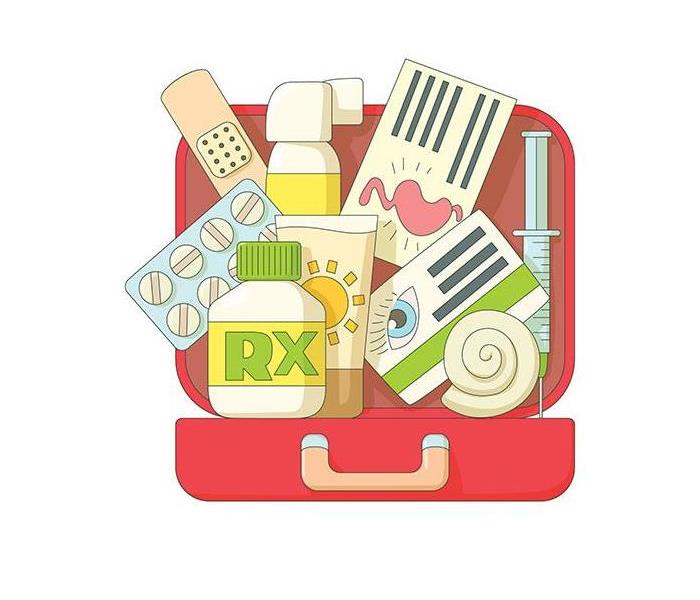 Emergency Kit
Emergency Kit
Storms happen, so why not be ready for it? Here is a list of recommended items to include in your basic emergency supply kit:
- Water- 1 gallon per person per day
- Food- non-perishable 3-day supply
- Manual can opener
- Battery operated radio, preferably a NOAA Weather Radio with tone alert and extra batteries
- Flashlight and extra batteries
- First aid kit
- Whistle to signal for help
- Clothing
- Dust masks or bandannas
- Plastic sheeting, garbage bags and duct tape
- Wrench or pliers to turn off utilities
- Local maps
- Hygiene items
- Important documents such as copies of insurance policies, identification and bank account information
- Cash
- Fire extinguisher
- Matches in a waterproof container
Other basic items to include:
- Non-prescription medications such as pain relievers, anti-diarrhea medication, antacids or laxatives
- Pet food and extra water for your pet
- Infant formula, bottles, diapers, wipes, diaper rash cream
- Sleeping bag or warm blanket for each person
- Prescription Medication
The dangers of flash flooding
3/16/2021 (Permalink)
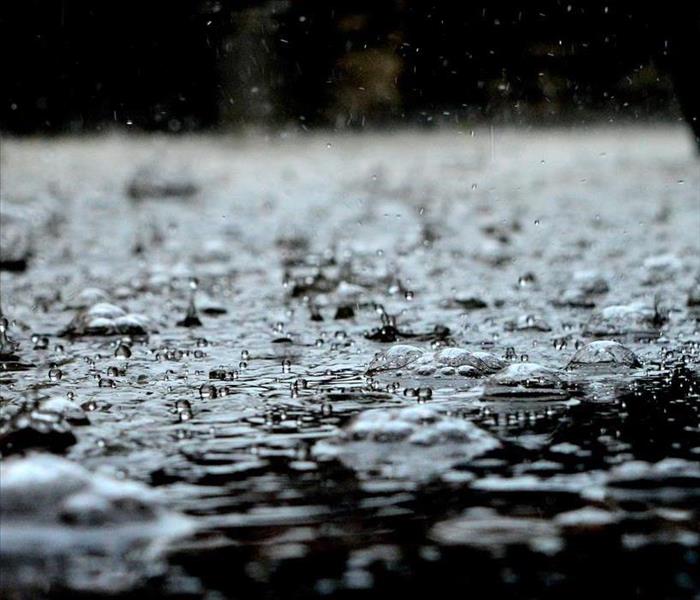 heavy rainfall
heavy rainfall
A flash flood is a rapid flooding of geomorphic low-lying areas: washes, rivers, dry lakes and basins. It may be caused by heavy rain associated with a severe thunderstorm, hurricane, tropical storm, or melt-water from ice or snow flowing over ice sheets or snowfields.
Flash floods can occur under several types of conditions. Flash flooding occurs when it rains rapidly on saturated soil or dry soil that has poor absorption ability. The runoff collects in gullies and streams and, as they join to form larger volumes, often forms a fast-flowing front of water and debris.
Flash floods most often occur in normally dry areas that have recently received precipitation, but they may be seen anywhere downstream from the source of the precipitation, even many miles from the source. In areas on or near volcanoes, flash floods have also occurred after eruptions, when glaciers have been melted by the intense heat. Flash floods are known to occur in the highest mountain ranges of the United States and are also common in the arid plains of the Southwestern United States. Flash flooding can also be caused by extensive rainfall released by hurricanes and other tropical storms, as well as the sudden thawing effect of ice dams. The United States National Weather Service gives the advice "Turn Around, Don't Drown" for flash floods; that is, it recommends that people get out of the area of a flash flood, rather than trying to cross it. Many people tend to underestimate the dangers of flash floods. What makes flash floods most dangerous is their sudden nature and fast-moving water. A vehicle provides little to no protection against being swept away; it may make people overconfident and less likely to avoid the flash flood. More than half of the fatalities attributed to flash floods are people swept away in vehicles when trying to cross flooded intersections. As little as 2 feet (0.61 m) of water is enough to carry away most SUV-sized vehicles. The U.S. National Weather Service reported in 2005 that, using a national 30-year average, more people die yearly in floods, 127 on average, than by lightning, tornadoes, or hurricanes.
Preventing an Ice Damming!
11/2/2020 (Permalink)
 How ice damming occurs
How ice damming occurs
ICE DAMMING - An ice dam is a ridge of ice that forms at the edge of a roof and prevents melting snow (water) from draining off the roof. The water that backs up behind the dam can leak into a home and cause damage to walls, ceilings, insulation, and other areas.
The article put out by www.weather.gov, shows how you can prevent or minimize the chances of getting an ice dam. We have had some nice warm weather up until now, but it's better to be safe than sorry. Take a look at the article by clicking the link below:
http://www.weather.gov/grr/roofIceDams
By installing extra insulation in your attic, adding roof cables to your soffits and gutters and making sure your gutters and downspouts are cleared you can help keep yourself and your home out of the path of water damaged ceilings, walls, floors or even flooded basements.
Will Your Roof Withstand Winter's Snowy Fury?
11/1/2020 (Permalink)
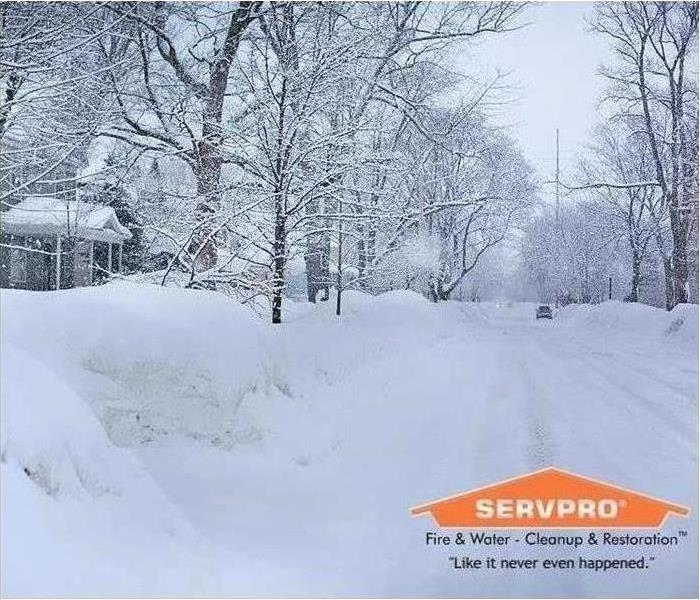 Call SERVPRO of Tarrytown/Elmsford
Call SERVPRO of Tarrytown/Elmsford
While snow-covered roofs can make for a picturesque winter scene, the combination of freshly fallen snow with the melting and refreezing of snow can place stress on the roof of your home or business. If more than a foot of heavy, wet snow and ice have accumulated on the roof, you should have it removed as soon as possible to prevent ice dams from forming.
Remember to avoid using ladders in snowy/icy conditions. This can be extremely dangerous and should be left to the professionals.
For Sloped Rooftops:
It may be possible to remove the snow and ice from your sloped roof using a roof rake – a long-handled tool designed specifically for this purpose. Stand on the ground and pull as much of the snow off the eaves as you can safely reach.
If you cannot safely reach the roof, contact a home builder, landscaping and roofing contractor, or property maintenance company to remove the snow and ice.
For Flat Rooftops:
If your flat roof is easily accessible from an interior stairway, you may want to shovel the roof, but be careful not to damage the roof covering.
Remember to put safety first any time you are on a roof, especially one that is covered in snow and ice. If you have any doubt, leave it to professionals.
How much snow is too much snow?
If you have had a big snowfall in your area and you are wondering whether or not your roof can support the extra weight, do not reach for a ladder or a shovel - reach for the telephone. Calling in a professional to remove the ice and the snow from your roof is always the smartest - and safest - option. Check out this article from houselogic.com that gives excellent advice on what you can do in this situation by clicking the link below:
Snow Removal Houselogic.com
Remember, if you experience a water damage as a result of an ice dam, frozen pipe, or snow covered roof, do not hesitate to contact SERVPRO of Tarrytown/Elmsford so our trained technicians can make your loss "Like it never even happened."
Just Call (914) 358-9000 and one of our staff members can assist you on getting your home restored as quickly as possible.
Floods Strike Everywhere
10/28/2020 (Permalink)
 Floods strike everywhere
Floods strike everywhere
Floods rank as one of the most common and widespread natural disasters in the United States.
Whether you live near a coastline, along city streets, in the mountains, near a river or even in desert, there is a potential for suffering flood damage. On average, floods cost $6 billion in annual losses in the U.S. The following are a few more little-known flood facts:
- Floods kill an average of 140 people per year in the U.S., making flooding the most deadly natural disaster.
- More than half of all fatalities during floods are auto related, often the result of drivers misjudging the depth of water on a road and being swept away in a swiftly moving current.
- The principle causes of floods in the eastern United States are hurricanes and storms.
- Underpasses can be some of the most dangerous places during a flash flood - especially at night, when it's difficult to see.
Be Prepared for Flooding!
7/31/2020 (Permalink)
 Call SERVPRO of Tarrytown/Elmsford if you experienced flooding in your home or business
Call SERVPRO of Tarrytown/Elmsford if you experienced flooding in your home or business
The following are tips from FEMA (Federal Emergency Management Agency) for preparing your home or business for a flood.
Before the Flood:
- Have a qualified professional elevate the furnace, water heater and electric panel if susceptible to flooding.
- Install "check valves" in sewer traps to prevent flood water from backing up into the drains of your home or business.
- Seal walls in basements with waterproofing compounds to help avoid seepage.
During the Flood:
- Turn off utilities at the main switches or valves if instructed to do so.
- Disconnect electrical appliances.
- Do not touch electrical equipment if you are wet or standing in water.
- Do not walk through moving water. Even six inches of moving water can make you fall.
After the Flood:
- Listen for news reports to learn if the community's water supply is safe to drink.
- Avoid floodwaters. Water may be contaminated by oil, gasoline or raw sewage. Water may also be electrically charged.
- Stay out of any building if it is surrounded by floodwaters.
- Return home only when authorities indicate it is safe.
Hurricane Storm Damage
5/28/2020 (Permalink)
 Aerial View of Hurricane
Aerial View of Hurricane
Hurricanes are large, spiraling tropical storms that can pack wind speeds of over 160 mph and unleash more than 2.4 trillion gallons of rain a day.The difference between a tropical storm and a hurricane is wind speed – tropical storms usually bring winds of 36 to 47 mph, whereas hurricane wind speeds are at least 74 mph. High winds are a primary cause of hurricane-inflicted loss of life and property damage. Another cause is the flooding resulting from the coastal storm surge of the ocean and the torrential rains, both of which accompany the storm.
Ways to Protect your Home
- Brace your garage door to prevent more-extensive damage
- Secure your windows and doors
- Protect your roof
- Trim your trees
- Take inventory
- Update your insurance
SERVPRO of Tarrytown/Elmsford's trained technicians are available 24/7 to assist with your cleanup and restoration needs, call (914)358-9000!
 Storm damage restoration for Dobbs Ferry homes need the help of SERVPRO. We are ready at a moment's notice.
Storm damage restoration for Dobbs Ferry homes need the help of SERVPRO. We are ready at a moment's notice.






 24/7 Emergency Service
24/7 Emergency Service
















